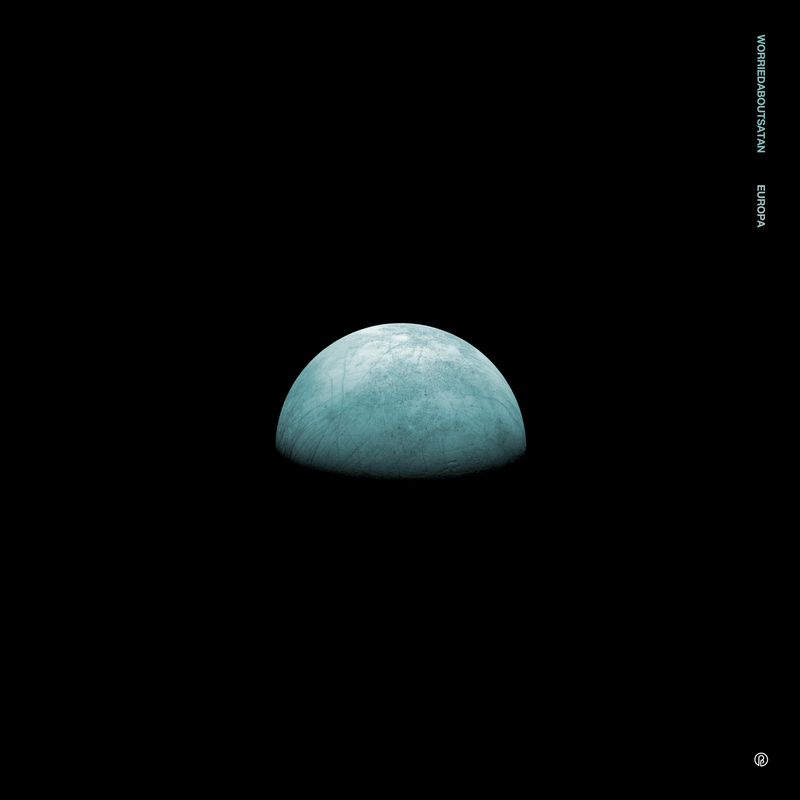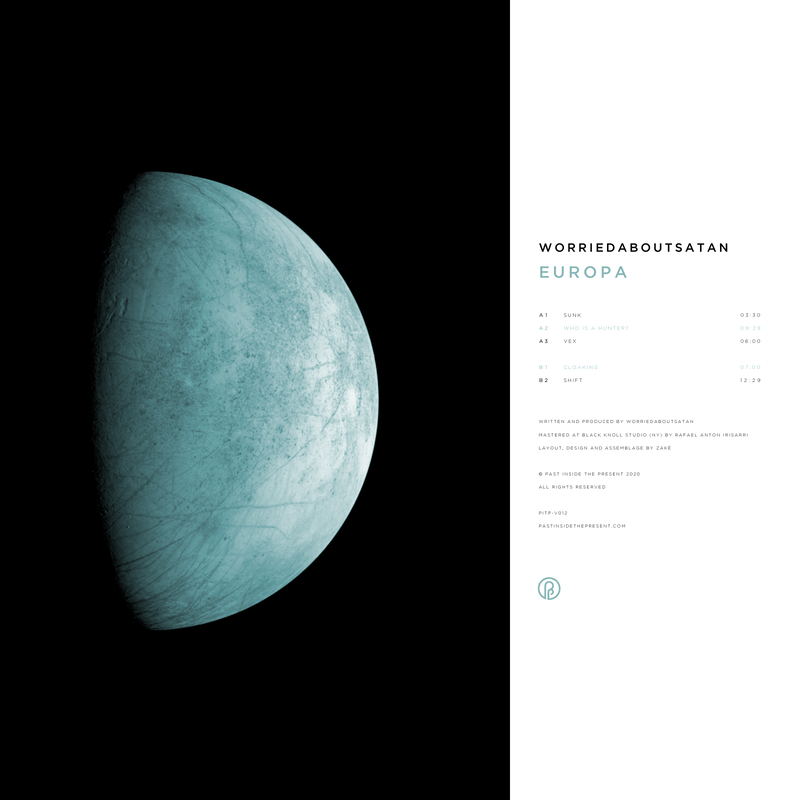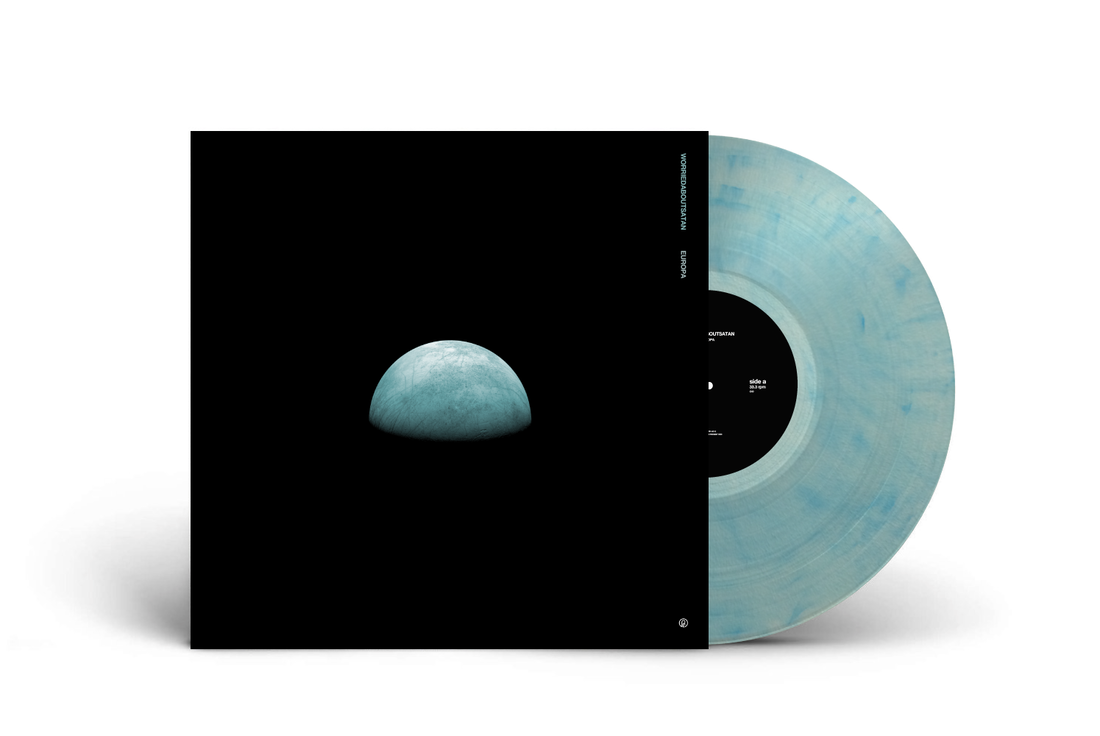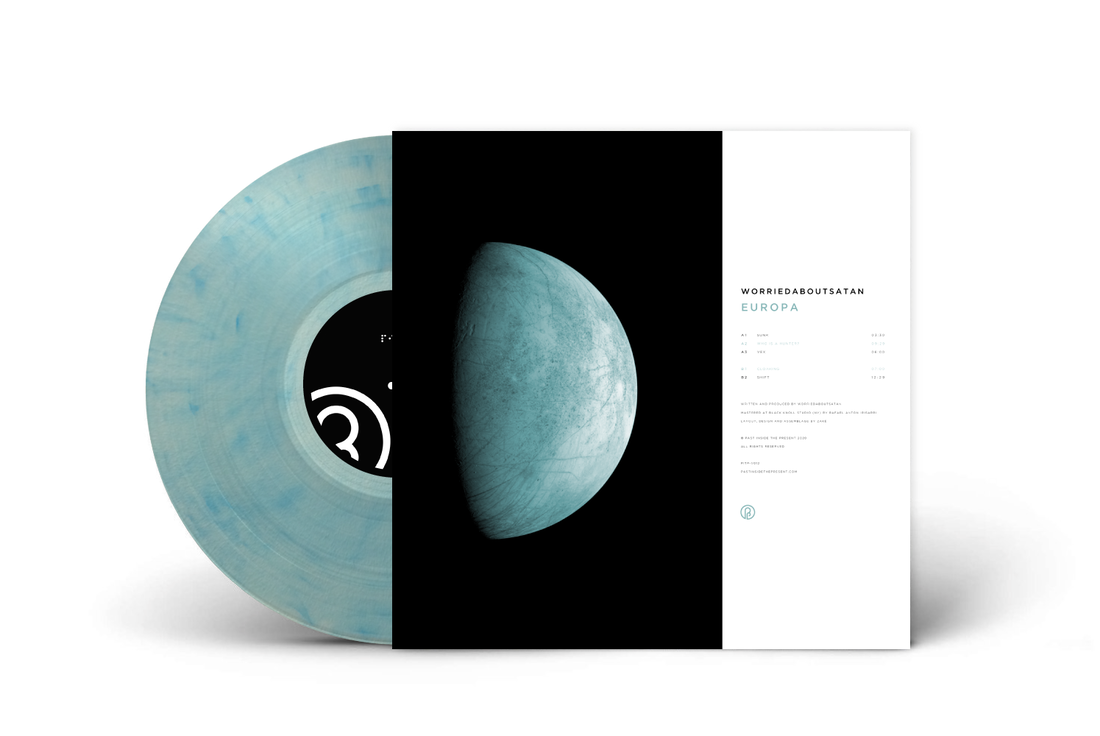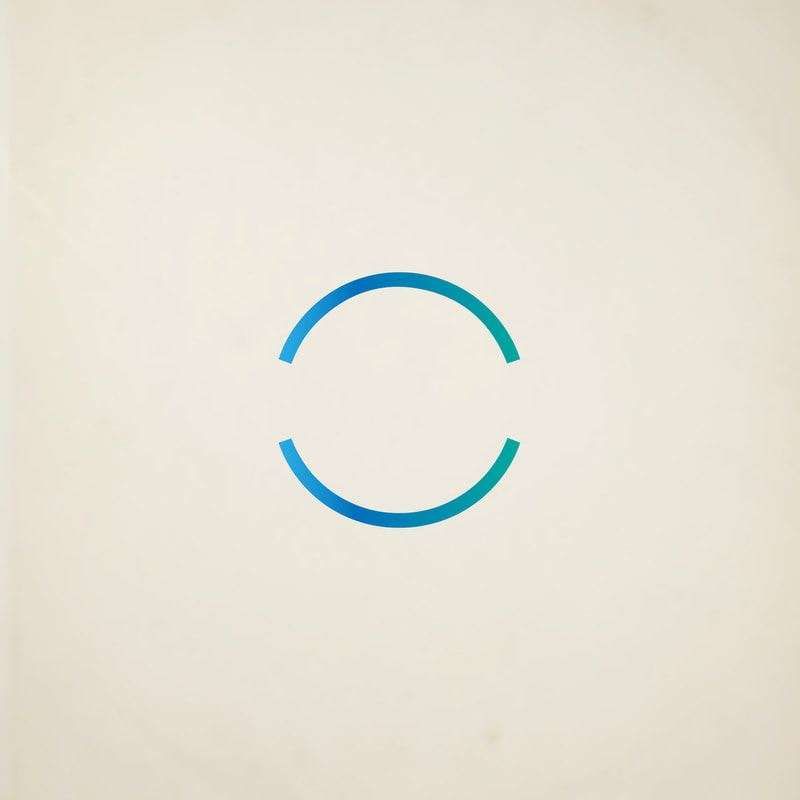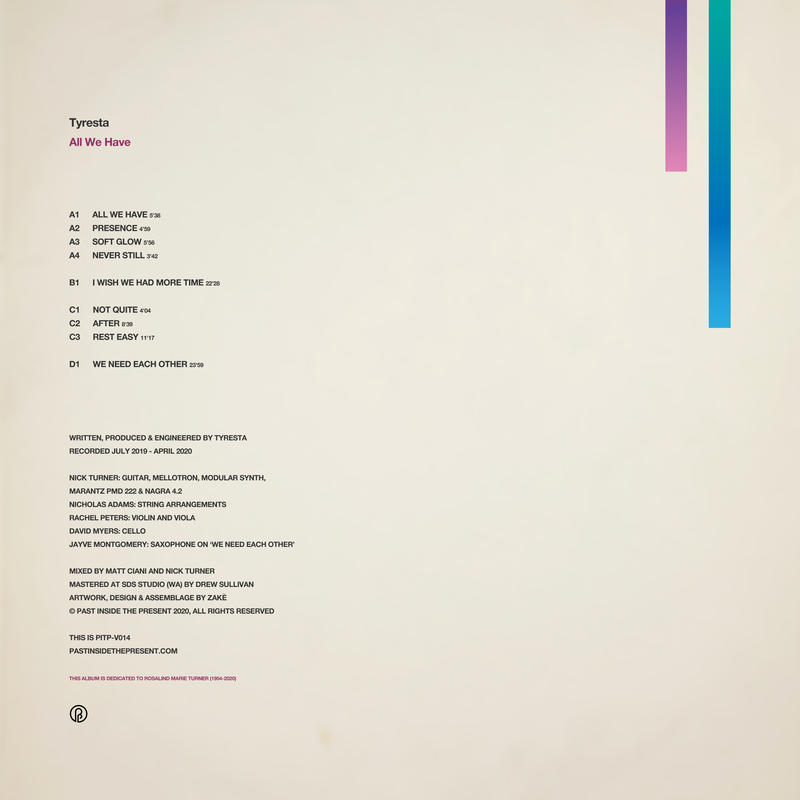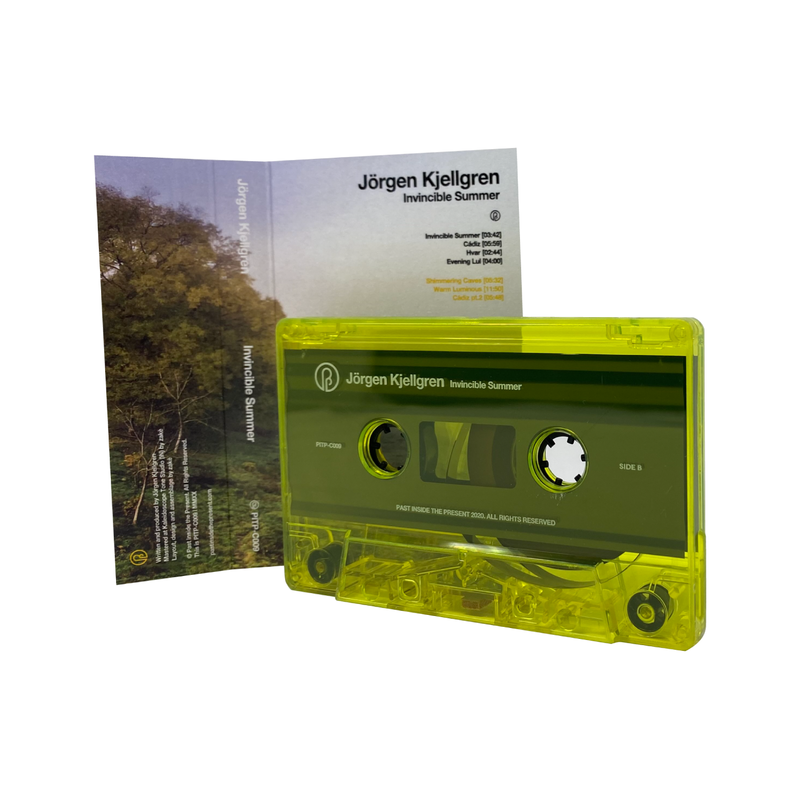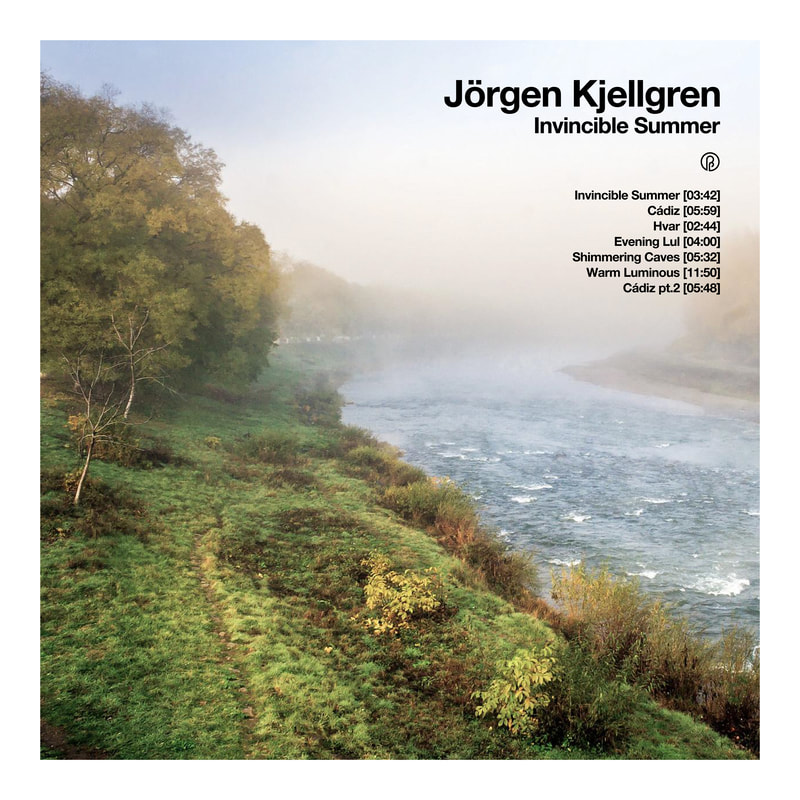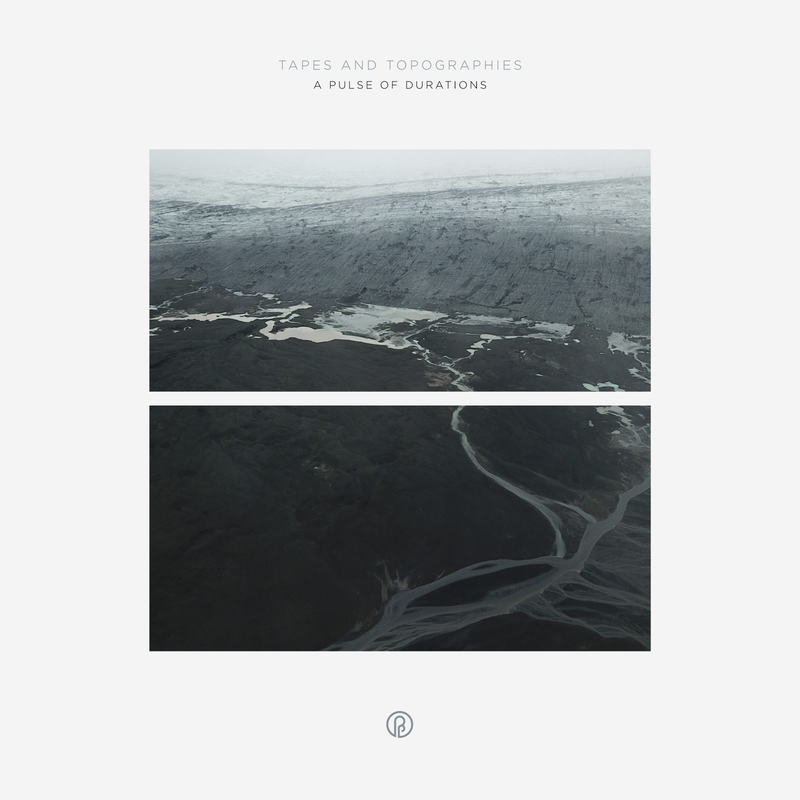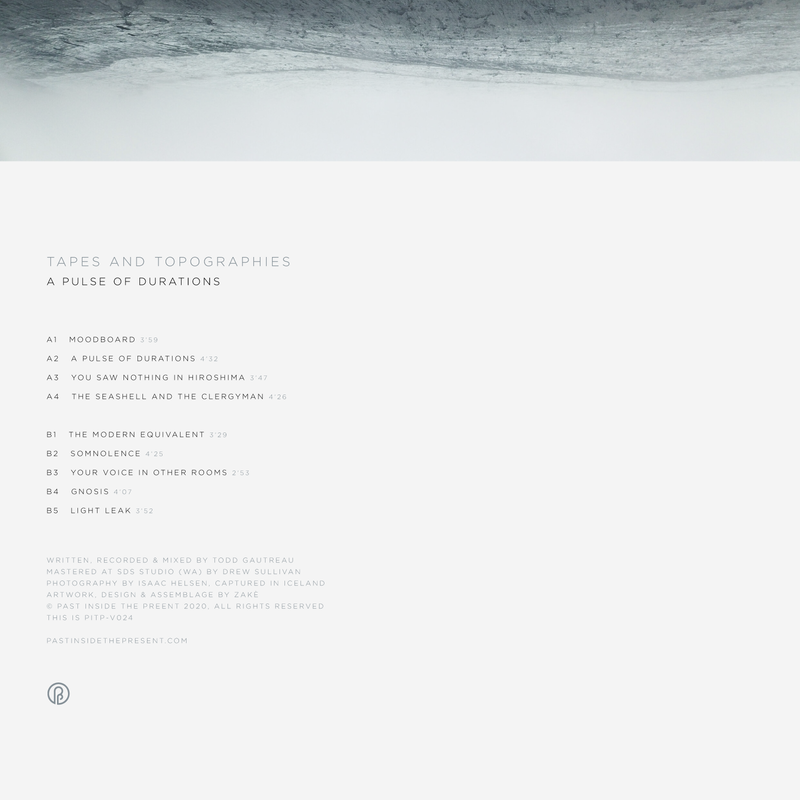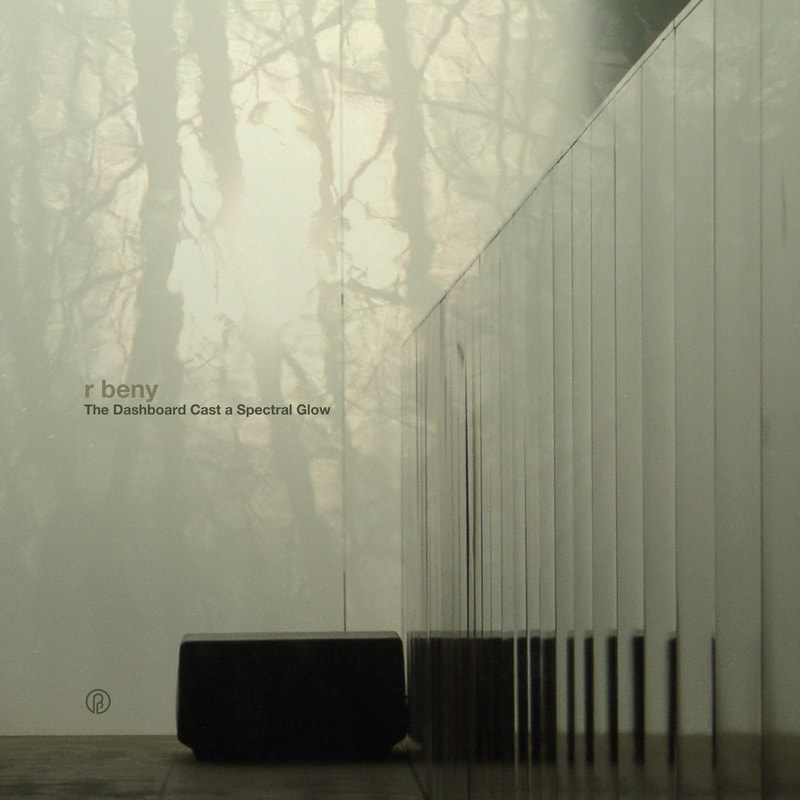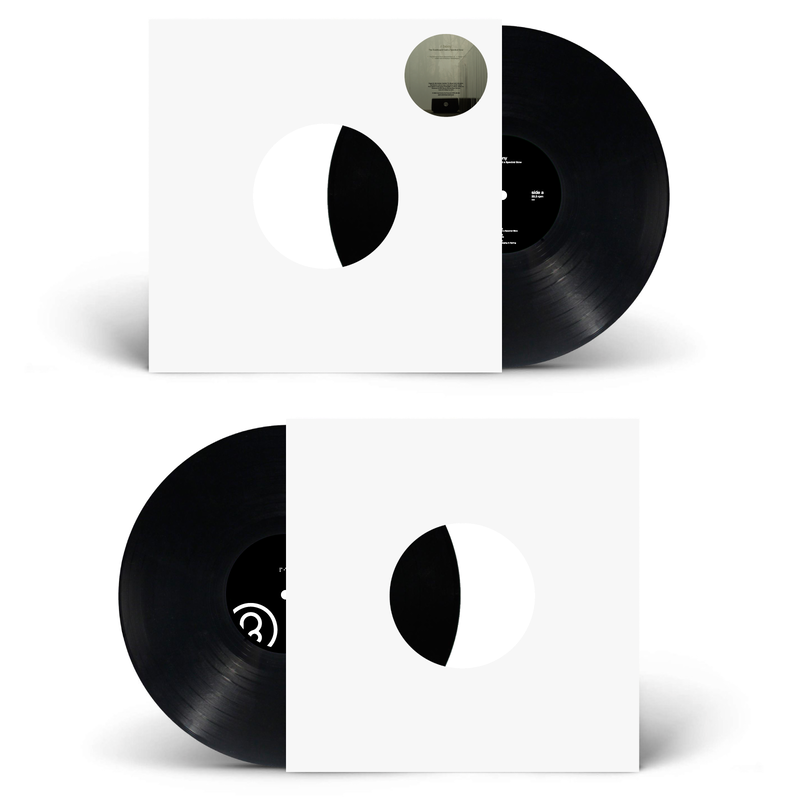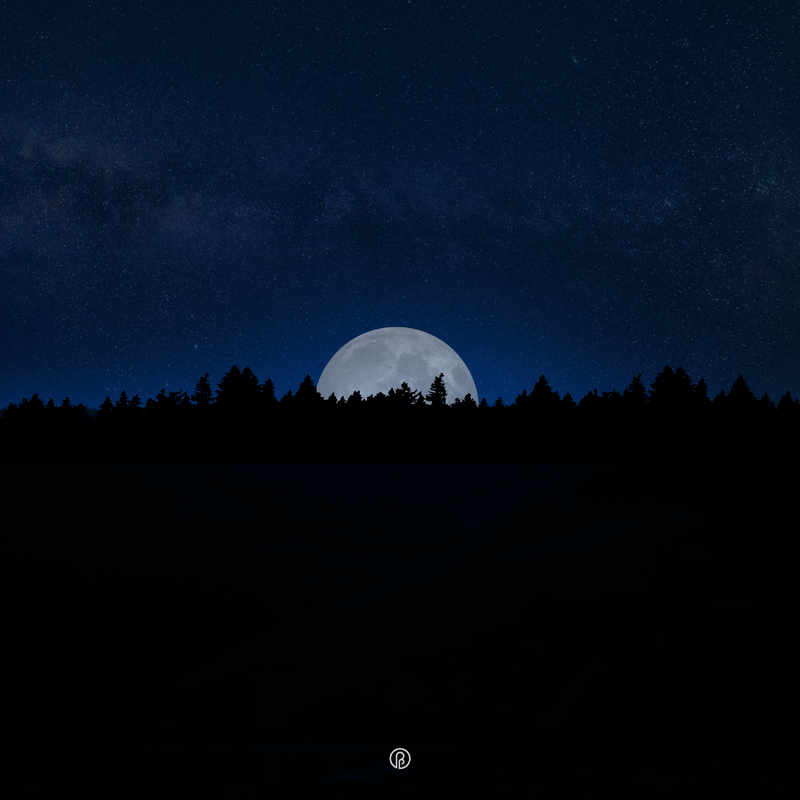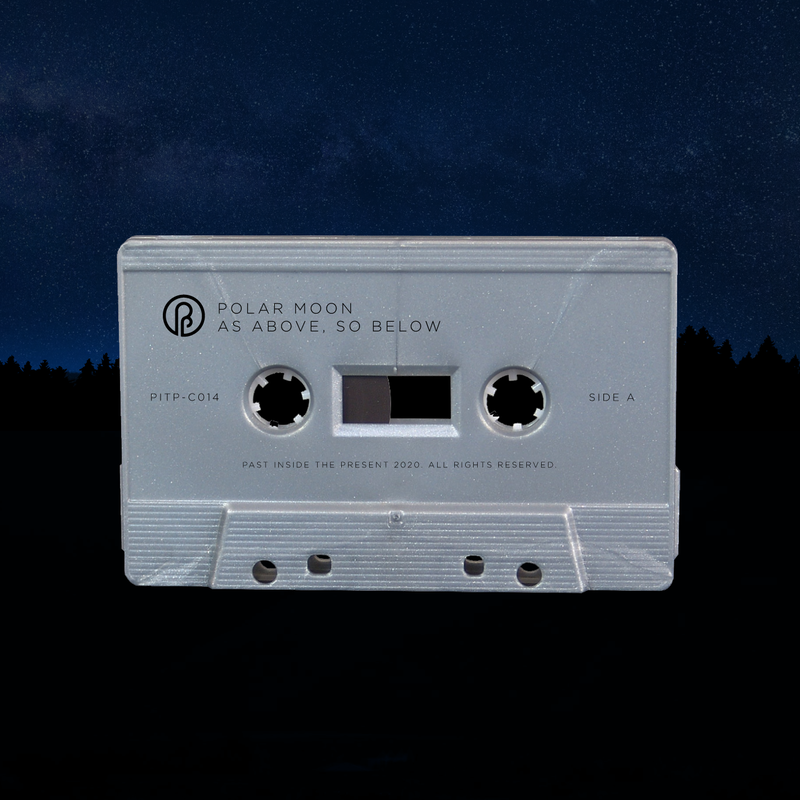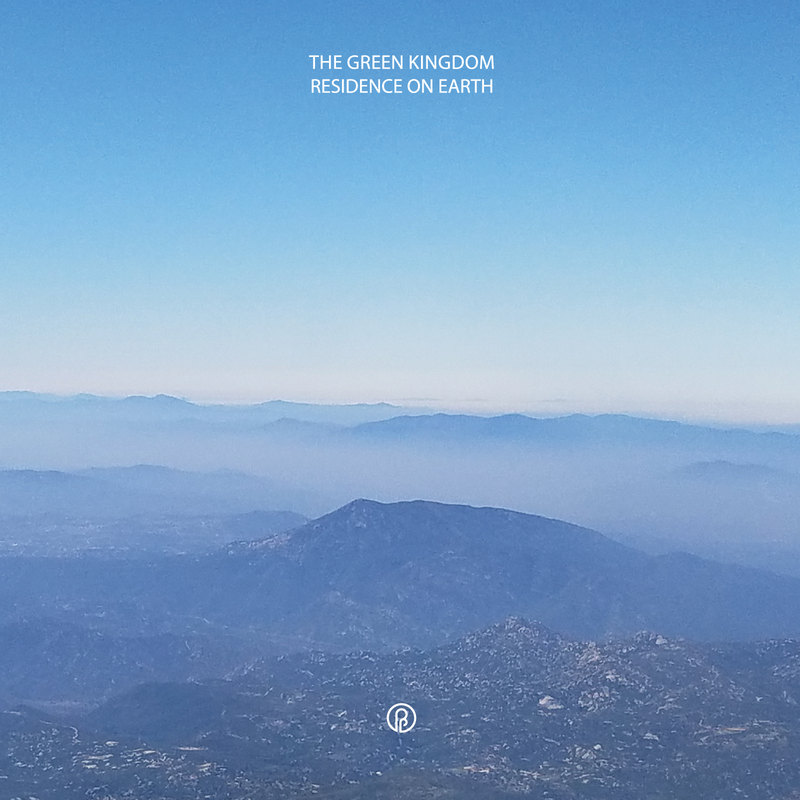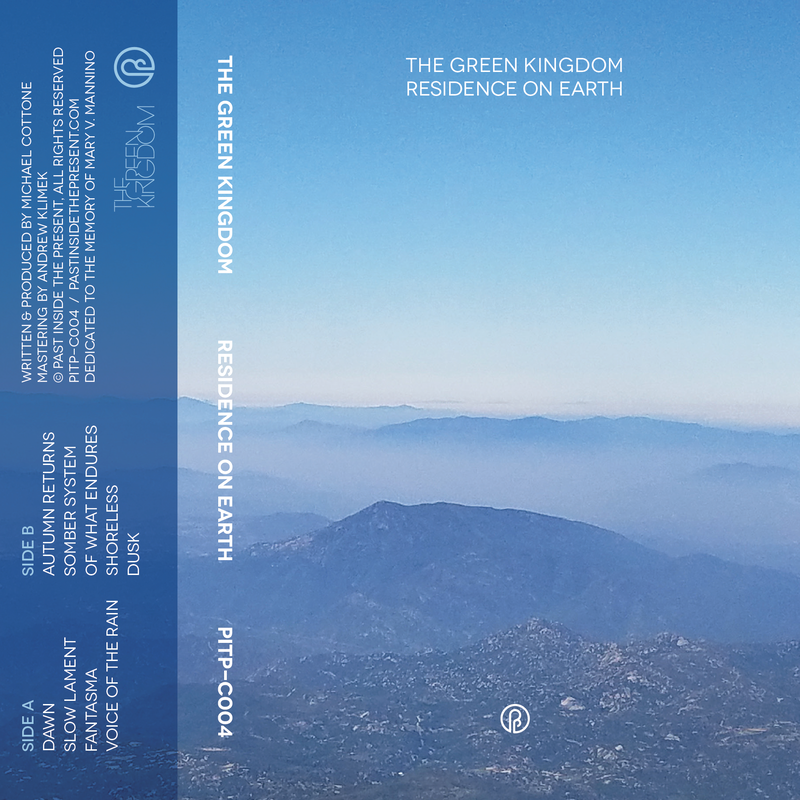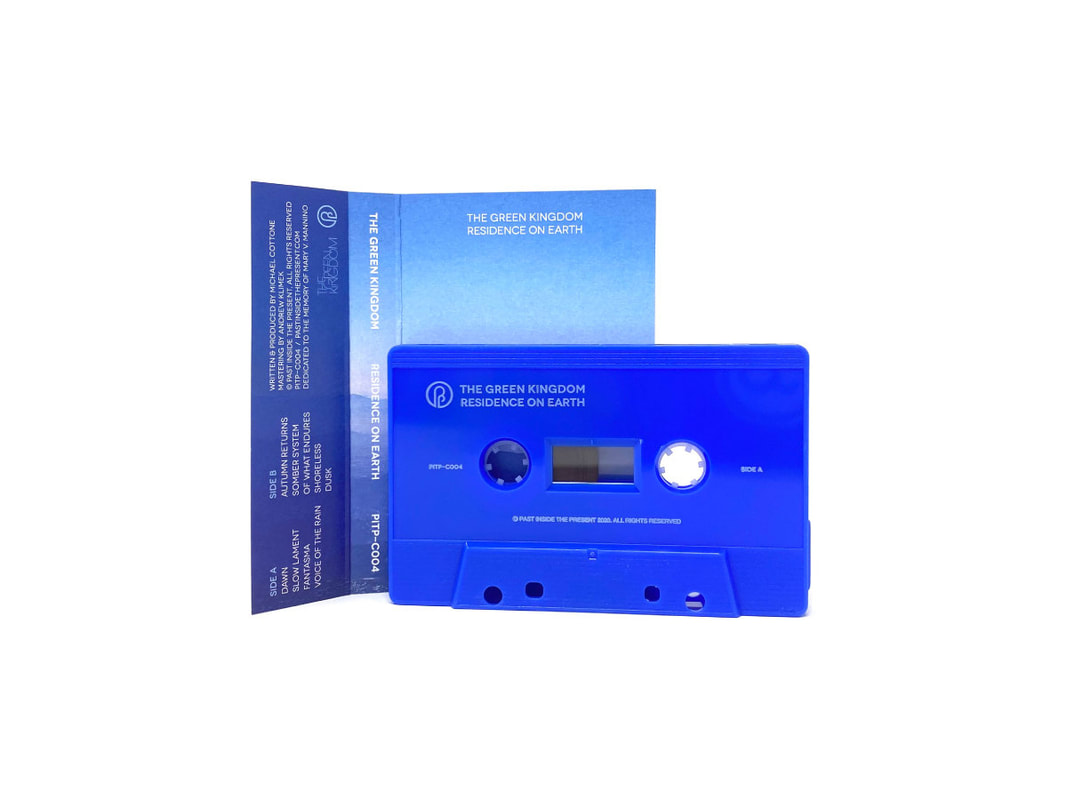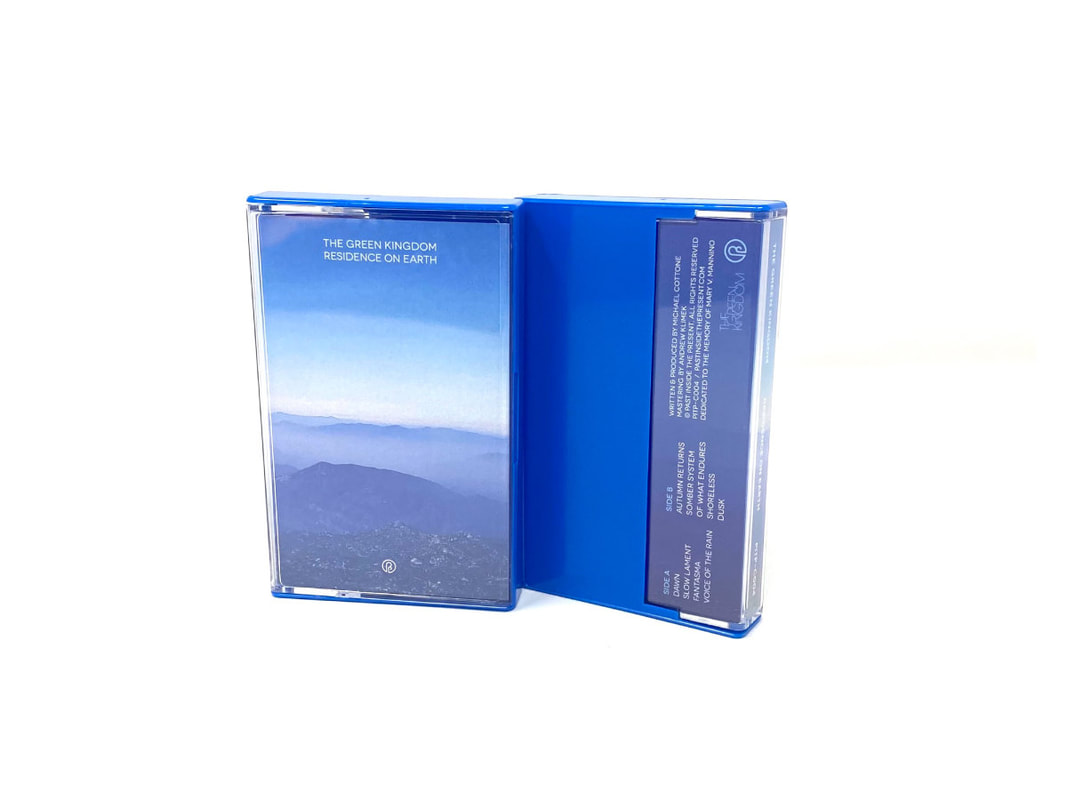|
Hi Gavin! It is a pleasure talking to you today. How are you doing?
W: I'm doing good, thanks! A little tired and a little sad that summer is kinda tailing off, but all good nonetheless. We are really excited to welcome worriedaboutsatan in our PITP roster. Please tell us a bit about yourself and how did you come to release this album on PITP? W: Well, I'm Gavin – I make music from a little home studio in Saltaire, a little village in the north of England. It's a world heritage site as it was a model village built in the Victorian times, so it's a bit weird living here, but I grew up just down the road in another little village, so it's not the biggest change in circumstances I guess :) I started making music as worriedaboutsatan in 2005, and have been kinda chugging along ever since. I think PITP popped up on my radar as we both swim in the same ambient circles, and I just got chatting with Zach one day I think – I had loads of material I remember, and I kept looking at that lovely logo and thinking “god damn I wanna be on that label!” haha! ‘Europa’ is amazing, congratulations! Let’s talk about it. What is this album about and what does it mean to you? W: Thanks! I really like it too. It kinda happened by accident, as it was Zach that floated the idea of a little introduction album, so Europa is somewhere between a re-issue, a best of, and a new single. It's a nice mix of the older satan catalogue and two new tracks too, but it's been programmed to flow like an original record, which is awesome. Who Is A Hunter? & Cloaking were actually part of a single from a few years ago, but a label that was supposed to put it out on vinyl never did, so I was always a little annoyed at that, as those tracks were made especially for the format, so when Zach suggested including them on Europa, it was one of those full circle moments! Beautiful how it all fell into place. The album is a perfect blend of ambient, drone, techno and post-rock. What is your approach when it comes to mixing these different genres? W: It's a strange one, as I started out in a post-rock band – y'know, the OTT overblown type, so when that band split up, and I started making electronic music, I kinda had that post-rock vibe in mind, but was trying to replicate the emotive quality through something other than a band format. I think I was a bit fed up with bands in general, and just wanted to experiment with electronics, which is how satan was born – coming at ambient, drone, electronica and techno, but from a post-rock background, so it's all I've ever known how to do! I'm always up for having a little look at a certain genre and seeing if there's anything I can pinch or bend to the satan sound, so it's nice to keep a fresh ear as to what's happening. Tell us about your process and influences for this album. W: As it's a compilation, the influences range a little more than usual, but the processes were still the same – just turn on bits of gear and see where they take you! Influence wise, Shift (part 1) was born out of a project which was attempting to make something long, flowing and free- form, rather than strict four-to-the-floor stuff like, say, Who Is A Hunter? Vex and Sunk, the two brand new ones, were more experiments in synthy, slow-core techno stuff and floaty ambience respectively. I guess most satan stuff starts as an experiment in something, and then it kinda falls into place as it goes along. Let’s talk about the beautiful artwork and ‘Europa’. What is your relationship with space and how did ‘Europa’ end up being the album title? W: Zach suggested Europa, and I think at one point he didn't know if it was any good or not, but I loved it straight away! I always think of myself as more European than English anyway (that's what a German side of the family will do to you), and I just really loved that word and the stark image of the moon itself on the cover – which is some more incredible work by Zach. Oh, and also – Europa is the moon they travel to in the not-so-successful-but-I-still-love-it sequel to 2001: A Space Odyssey, 2010. Properly underrated film, Helen Mirren's great in it. What is your favorite track on the record and why? W: Ooh, tough one. I really like Shift, but I'll say Vex as it's a new one. It was the first time in a long time where I sat down with a guitar and played stuff that was hovering around the same key as the synth, but wasn't necessarily the same chords or notes – I remember thinking “oh shit, yeah – you can do this can't you?” haha! Really nice guitar bits on that one. In general what inspires you to write music? W: Kind of anything really. I think I'm a melancholic person in general, so when it comes to making stuff, I'm never going to ply a trade in major chords, so I like to try and see what I can do with the more subdued end of the musical spectrum. Sometimes I'll just get an idea and think 'yeah, I should try that!', and see what I can mold it into. Other times I'll just sit down and try to kick off with a small idea and see where it heads. What are you listening to these days? Any artists that you admire and continue to be inspired by? W: Yeah, I'm listening to quite a fair bit at the moment. I like to listen to a lot of stuff across genres as well, as I think it keeps you on your toes a little more. You can always tell when people only listen to techno, or just ambient or whatever. I think I'm too restless for that, so I will load up a Carly Rae Jepsen album or something. I mean, she's amazing – something like Too Much, or Gimme Love has had more impact on me than a lot of the big ambient/ drone guys. Also really like FRKTL, she's awesome. Her new record is just incredible – it sounds so ferocious, yet has this heart to it as well. Also really like that new Hayley Williams album, that new Charli XCX one as well, and more often than not I'll bang on a bit of HTRK – I could listen to them all day, I really could! Their atmospheres are just beautiful. They have a real yearning quality to them that's so hard to replicate - they just leave stuff up in the air, and only bring it back down when it's totally needed. A live show/tour for this record would be such a great experience. Do you miss live shows? When we can put social distancing behind us, is playing ‘Europa’ live something you want to do? W: Hell yeah! I think 2020 is the first year since 2004 where I've not played a live show, and it's horrible! Playing live was always something I really believed in doing, and making it much more of a live show than a lot of electronica guys do. There's a tendency to just load up a laptop and sit there, poking at buttons for an hour, so when I first started looking at a new live set, I ditched the iPad, and bought a drum machine, as I wanted things to look and sound a lot more organic – I wanted to get away from just triggering loops of Garage band, and get a bit more hands on. I've been doing a few live-streams on Instagram & YouTube, but it's not the same as being on stage in front of people. It's nice though, don't get me wrong, and it's been great to play some guitar for people over the past few months, but I'm really itching to get back onstage with all this stuff and play for people. I'm not going to be one of these douchebags who play gigs during a pandemic though, that's just so daft. Thank you for taking the time. Any last words you want to share with people out there? W: No worries! Hmm... last words? Erm. How about Up The Villa? (it's a football thing) Hi Nick! How are you and how is life in Chicago? T: Hello! I’m doing ok. It’s difficult to remain grounded when things feel so volatile and untethered. Though systemic racism, police brutality, and pandemics existed prior to 2020, they have been in the forefront this year and it’s frustrating when people resist doing what needs to be done in order to solve those issues in the long run (defunding the police, community investment, universal health care, etc.). Tyresta started around 2016. Please tell us more about yourself and this project. How did the relationship with PITP start? T: 2016 was a year full of ups and downs for me. I got engaged and was married to my partner. My mom was diagnosed with Pancreatic cancer a month before the wedding and Donald Trump was elected president a few months after that. I sought refuge in music making as a way to cope with what was going on around me and hopefully help others do the same. I’m a clinical social worker/therapist so I think a lot about healing, self-care, and growth. The idea for Tyresta came when I was on my honeymoon in Sweden that fall (Tyresta is a forest within the city limits of Stockholm). I listened to the audiobook about Brian Eno’s Another Green World by Geeta Dayal on that trip, which I found particularly inspiring. I definitely identify with the title “non-musician” which Brian Eno popularized. I took guitar lessons when I was younger but I am woefully inept when it comes to music theory and production, which is why experimental music is so appealing to me. Formal training shouldn’t be a barrier for creative expression. As far as PITP is concerned, I was on Twitter one day in early 2019 and saw that Zach had posted about wanting “ambient tape recommendations”. I sent him a link for one of my tapes and the rest is history. Though my tendency to over-engage with social media is mostly detrimental to my mental health, I am grateful I was on Twitter that day. Congratulations on the new album! It’s your first physical vinyl LP. It’s actually more than an LP it’s a 2xLP! How does it feel? T: It feels very surreal. There are so many amazing artists out there that don’t get the chance to release their music on vinyl (let alone a 2xLP set) so I feel very lucky and fortunate. I am immensely grateful for the PITP team for taking a huge chance with this release. I can’t thank them enough for their encouragement and support. ‘All We Have’ is really intimate and personal to you. If you are willing to share, could you tell us more about this album and what it means to you? How did you put all the tracks together and what was your process for that record? T: The title was inspired by the idea in Zen that “all we have” is the present moment. The past is fixed and the future has yet to occur. Through ruminating on the past or worrying about the future we miss what is happening right in front of us, which causes us to suffer even more. I attempted to approach my mom’s three and a half year battle with cancer from this mindset. We didn’t know how long she was going to live and I wanted to be as present as possible for whatever time we had left with her. I wasn’t always successful but my mindfulness practice definitely helped me to show up for her even when it was painful to do so. I started writing the album at a time when her cancer was relatively stable. We were somewhat hopeful that she was going to be able to live a lot longer than we initially thought, which is why Side A of the album feels a bit brighter and hopeful. After a few months of writing and recording, her cancer began spreading again and she started a really brutal episode of treatment, which lasted up until her death in February of 2020. Sides B and C on the record are about the last few months of her life and what we were going through emotionally as a family. Both trying to remain hopeful while also knowing she was very sick and spending more and more time in the hospital. Side D is sort of an epilogue and is a commentary on the state of the world as a whole. Fear drives things like racism, oppression, and hoarding behaviors (including wealth, power, and control) and we continue to devalue collectivism, mental health care, and the cultivation of emotional intelligence. You invited a few friends on the record. Tell us more about these contributions! Do you like collaborating with other artists? T: I really enjoy collaborating with other artists. Especially those that are more formally trained in music composition, theory, and production. Nick Adams provided string arrangements and had two of his friends record cello, viola, and violin parts for some of the songs. Not all of those parts made it onto the album but a few did. Jayve Montgomery plays Saxophone on the final track “We Need Each Other”. This track took many forms over the course of the year it took to write and record the album. Jayve’s sax added another layer of emotional depth to the song, which solidified the track for me and it ended up being one of my favorites on the album. The mix of guitar and mellotron is really well crafted on the album. Do you have a go to setup or favorite instruments/gear for making music? T: I try not to have a “go to” set up for music making. I mostly just see what I’m compelled to pick up in the moment and then start experimenting. For this record, I focused on guitar, mellotron, and my Marantz PMD 222 field recorder/tape player. I also used an Electro-Harmonix looper on many of the songs. Though much of the music I have released as Tyresta has been focused on modular synths, I barely used them on this record. Let’s talk about Fallen Moon Recordings [a PITP digital only sublabel]. Please tell us more about it and what is your goal managing that label? T: PITP receives a lot of demos and some of them are great but don’t really fit the sound palette we are going for as a label. In May of this year, I suggested that we start a more experimental side label and offered to head up the project and the others on the PITP went for it. My goal is to showcase a broad range of artists and as much as possible try to transcend the confines of contemporary ambient and drone music. I am also trying to find ways of collaborating and showcasing artists with marginalized identities. It is often the case that white, cis-gendered, male artists (myself included) get the spotlight in experimental music, which doesn’t accurately represent the wealth of diversity amongst artists in the scene. Thank you for talking with us today. Any last words you want to share with people out there? T: No problem. Thanks for the interview. Interviews like these help me understand myself and my music better. And for those reading this interview, thank you for your interest and please take care of yourselves and others. Hi Jörgen! How are you doing?
JK: I'm well, thanks! The sun is out, and I have some time to chill and do a bit of reading. I kind of overdid it with my pre-vacation book shopping this year, and now I'm struggling to keep up :) You live in Sweden, how is life over there at the moment? Did your summer change because of the Covid-19 situation? JK: We had plans to go to Portugal this summer, originally. But when Covid-19 hit, we quickly decided to stay in Sweden. Which, as it turned out, was what the government decided we should do also. I've had a great summer with my family, staying close to the ocean and just kicking back. Speaking of summer, congrats on the new album' Invincible Summer'! It's a powerful name if we consider these strange and difficult times around the world. In the album description you shared that it came from a quote by Albert Camus, please tell us more about that! JK: Thanks! The quote from Camus is, "In the midst of winter, I found there was, within me, an invincible summer." I've carried it round in my head for a few years. To me, it describes what happened inside of me when I met my wife, and we later turned our two small families into a more regular sized one. Like, there was a thawing happening. In the context of Covid-19, I think the quote speaks of hope and perseverance. Things can seem very bleak, and there's so much heartbreak, loss, and fear. But even this is not forever. What was your process and influences for writing this album? JK: The album is made up of tracks I've collected over maybe six months or so. They are meant to capture memories or remembered emotions and moods from time spent with my family traveling in the summer. The track titles are places we've been to, mostly. In a way, the album is a love letter to my family, as cheesy as that may sound. Gear wise, it's mostly my OP-1 and a few guitar pedals. I've been making stuff on the fly, on trains, in summer cabins, wherever. Then I've resampled things through pedals, slowed them down, things like that. There's so much music I listen to all the time. I don't think I had any specific artists that I tried to emulate on this album. But I've been listening to a lot of H. Takahashi, Federico Durand, Green-House, Laraaji, Josh Mason, Senoy, Julia Bloop, Lungfulls, and xJK. lately. Currently, I'm on a bit of a lofi tangent. We'll see how that affects upcoming projects. This album feels deeply meditative. How do you approach making this type of music? JK: First of all, that's a great compliment to me. Thanks! I don't know that it's something I do on purpose, that meditative thing. I do try to "do less" when I work on a track and just let it happen. I guess you could say I try to discover tracks rather than make them if that makes any sense. Also, the whole meditative thing could just be a reflection of my inner tempo. What would you say are the ideal listening conditions for this album? JK: Probably when you're moving. Train rides should be good, but also walks along water or in the forest. And maybe early in the morning? Do you have a personal favorite track on the record? Which one would it be and why? JK: Evening Lul, I think. Such a banger! You have a track on the PITP comp "Healing Sounds II", how do you see music and charity work fitting together? What are your thoughts on helping people in need through art? JK: I was very honored to be asked to contribute a track on that comp. As an artist, I think there are a few good things about projects like that. You get to help to raise money and help people in need, and at the same time, your music may offer some solace to the listener. In times like these, when the world seems filled to the brim with worry, I hope ambient music can have a function beyond your average "work focus" playlist scenario. You are part of a music duo called Little Boxes. How do you approach working in a pop duo compared to your solo ambient project? JK: Little Boxes is the band I have with my wife, and it's completely different than my ambient stuff. We do a more electronic pop kind of a thing, where I get to sing harmony and play guitar and stuff in a more structured setting. My wife is a great singer and producer and writes great lyrics. The original idea was to see how much of a ruckus we could make between the two of us. Quite a bit, it turns out. It is also an awesome way to spend time with someone you love. You just open a bottle of red, fire up the gear, and make an evening out of it. Then there's the collaborative aspect, where the end result is something that we'd never had come up with on our own. What are you listening to lately? Do you have any recommendations for us? JK: I've been going back to what got me into electronic music in the first place. So Teebs and Evenings have been getting some airtime this summer. Also, the new Duelling Ants release is great. Then there's Meitei, Khotin, Ulla Straus, Golden Retriever, Josh Mason again... Thanks for taking the time to talk to us! Congrats again on the wonderful album. Any last words for people out there? JK: My pleasure! I hope people enjoy the album, and I also hope people try to find a moment every day to just let go of whatever is going on currently (I know there's a lot) and enjoy a little peace. Hi Todd! Glad to talk to you today. How are you doing? TT: I am well, thanks. Working on the next record at the moment. For people who might not be familiar with your work, please tell us a bit about yourself and the origins of Tapes and Topographies? TT: I first began releasing ambient music as Tear Ceremony many years ago. I then detoured into downtempo for a while with Sonogram then in 2014 I returned to ambient with Tapes and Topographies. A Pulse of Durations is the 8th Tapes and Topographies release. You also run a label Simulacre Records, could you tell us a little about how that came to be? What other labels have you worked with and how did you come to work with PITP? TT: After releasing the first Tear Ceremony record on Germany’s Machinery Records, I started Simulacra primarily to release my own work and that of a few close friends. This was manageable when I was doing one release per year but lately I’ve been doing 3 or 4 releases per year which left little time for label duties. I decided it would be better to seek the help of a label. PITP was familiar with my work and they had an impressive roster so I reached out to see if they would be interested in doing the new record. The new album is wonderful, congratulations! What is this album about and what does it mean to you? TT: Most of my work explores similar themes of dreams, memory, time, loss. I suppose It’s an attempt to document the human condition or at times just to comfort myself. In the description that accompanies the album you said that the album was influenced by the films of Tarkovsky and Resnais, please tell us more about this! TT: I’ve always been influenced by the likes of Bergman and Cocteau. For this record, I absorbed other cinematic influences particularly Resnais’ Hiroshima, Mon Amour, Tarkovsky’s Solaris, Louis Malle’s The Lovers and Antonioni’s La Notte. In these films, time seems suspended as in a dream and there is such poetry in the journey of the protagonist. An underlying despair which is unresolvable. I try to capture some of those feelings in miniature in my music. The title ‘A Pulse of Durations’ is taken from Scott Walker’s song ‘Angel of Ashes’. Scott Walker was truly a one of a kind artist and his passing last year was a great loss. Did he have a big impact on your musical journey and this release in particular? What other artists have had a big influence on your work? TT: I don’t know that his sound had an influence on mine but I find his trajectory inspiring. He was always pushing the envelope. Many found his last couple of records impenetrable. Even I sometimes secretly hoped he would return to his majestic croon before he left us. I first discovered him many years ago, long before the 4AD resurgence and even then there was so much of interest in his catalog to explore. He was certainly ahead of his time. I was astonished he had escaped my gaze for so many years. But his records were extremely difficult to find in the US at that time. The music on this album is ethereal, dreamy, powerful and (at times) dark. What was your approach and process in writing, composing, and recording this record? TT: I normally focus on a limited palette for each release and then try to remove something and add something new for the next one to keep it interesting. This might be adding new gear or changing the workflow, usually a bit of both. Once I have a couple of tracks, the rest tend to come quickly. Sometimes there’s a vague theme guiding it all for inspiration, but usually nothing too explicit or restrictive. What gear did you use on this album? And what is your thought process in regards to gear selection in general? TT: I recently started using a hardware looper more often than software along with more effects pedals over plugins. I find these tactile differences lead to more spontaneity. The new record is primarily sample-based, I don’t think there any actual synths on this one. There are a few heavily processed guitars. The Avalanche Run and Electro-Harmonix Super Ego Plus are good for smearing the attack away so you end up with more of a soundscape. I am using the Electro-Harmonix 95000 looper which is more than I need but it’s very intuitive with few menus and little scrolling required. I’ve recently become more adventurous with trying different gear and if it doesn’t work for me just getting rid of it and trying something else. On the next record I’m working on now, I am using a couple of analog synths (Model D and Minilogue) and experimenting more with microloops. I prefer to accidentally stumble on inspiring sounds than to spend too much time programming. I have not yet ventured into modular synths. What is your favorite track on the album and why? TT: It changes often but perhaps the title track, it best encapsulates the feel of the record as a whole. Thank you for talking with us today. Any last words you want to share with people out there? TT: Thanks to everyone for listening. --------------------------------------------- 'A Pulse of Durations' by Tapes and Topographies LP // Digital 08/07/2020 'With "A Pulse of Durations" I found myself attempting to strip things down to find the beauty of each core idea instead of hoping to find it through further embellishment. During this period, the films of Tarkovsky and Resnais were influential for their atmosphere and dreamlike qualities. The title is taken from Scott Walker's "Angels of Ashes". I've always found it to be a lovely and undefinable phrase.' -TG Written, Recorded & Mixed by Todd Gautreau Mastered at SDS Studio (WA) by Drew Sullivan Photography by Isaac Helsen Artwork, design & assemblage by zakè -- © Past Inside the Present This is PITP-V024 | MMXX PITP.bandcamp.com pastinsidethepresent.com Hi Austin! How are you doing today?
RB: I am well. I have about 30 things on my to-do list and the it seems like the world is falling apart, but I am well all things considered. For people that aren't familiar with your work, tell us a bit about your background and what led you to start releasing music as r beny? Also, if you are willing to share, what is the meaning behind the name? RB: Like many do, I grew up playing guitar in bands throughout my teens and early 20s. While I loved making music and being in bands with friends, I never felt fully comfortable with the guitar. I felt like it was difficult to express what I wanted to express with music, I think due to my own lack of skill and the limitations of the instrument itself. I had a crossroads moment in 2014, where I was finally able to admit this to myself. All of the work put into practicing, writing songs, and playing gigs had become a source of frustration, rather than one of joy. It was a bittersweet epiphany, considering my passion for music. I ended up quitting the band I was in, sold most of my gear, and put myself into other hobbies. About a year later, I was at a friend’s house and he showed me a synthesizer he had recently picked up, a Korg Monotribe. We played with it for a few hours and I found it insanely fun, so I decided to pick one up for myself. I ended up with a Korg Volca Keys instead, since the Monotribe had been discontinued. While I always had an affinity for electronic music and instruments, I had never really understood my way around a synth or a sampler. I had a Korg Microkorg a few years back and never figured it out beyond just switching between the presets. As I started to properly learn about synthesis and sound design, it all just clicked into place. I found that with these instruments and tools, I was finally able to express myself musically the way I so desperately wanted to. It all kind of snowballed from there, getting into DIY electronic instruments, then modular, then starting to record and release music. “r beny” came about as a pseudonym for my work with synthesizers and other electronic instruments. It was actually a placeholder name, I had quickly made a YouTube channel one day to do a tutorial for some people on the Korg forums. At the time, I was obsessed with the work of photographer Roloff Beny. The name “r beny” was a tribute to him, while also being what I thought was somewhat vague (in my head, I thought it sounded like a word from another language. I now get called “Beny” quite a lot). I meant to just do that one video and then make a real channel for better thought out tutorials later down the line, but the video blew up outside that circle and the name stuck. Congratulations on the new album! We have been looking forward to working with you on a release for quite some time. How did this album come to be? RB: Thank you! Last year Past Inside the Present reached out to me to propose a 10” vinyl release. As a fan of the label, it was an easy decision to say yes. The timing and situation was just right. I get a number of requests to release music, but I tend to work on music at my own sporadic pace and don’t really have extra material at the ready. 2/3 of the tracks on this EP (Fjorda and Golden Larch) were tracks I started working on and playing live last fall. They were inspired by my time touring in Europe, earlier that summer. They both started as sketches I made on the Novation Summit synthesizer and then later fleshed out. I think there were some issues with pressing the 10” records, so the EP is out on 12” instead. I am pleased to be a part of the PITP family and community! The title ‘The Dashboard Cast a Spectral Glow’ is quite powerful and fits the music perfectly. What is the meaning behind both the song titles and the music you put together for this release? RB: The EP title is a play on a line in a book I read called Blue Highways by William Least Heat-Moon. “The early darkness came on. My headlamps cut only a forty-foot trail through the rain, and the dashboard lights cast a spectral glowing.” I have a journal where I write down interesting or affecting words or phrases that I read in books, hear in movies/tv, and see in everyday life. For me, this line encapsulates the feeling I try to emote with my music. Those little lost, in-between moments. That brief feeling of longing for your past you randomly feel as you drive through the forest and the sun breaks through the canopy of leaves. The vision of dashboard lights cutting through the darkness, as it starts to set in the middle of the woods on a rainy evening, felt so familiar. I knew it would inspire the name of a track or release as soon as I read it. “Fjorda” is play on the word fjord. I had the opportunity to visit Iceland last year, right before my European tour, and I was so struck by the beautiful landscape and nature. I had wanted to visit Iceland since I was young, so it was fantastically surreal actually being there. It felt like a dream. When I got back from that tour, I wrote a song called “Fjossa”, which was a play on foss, the Icelandic word for waterfall. It was sort of a portmanteau of foss and fjord, a made-up word describing this floating feeling of waterfalls, water, and nature. “Fjorda” is a sister track to “Fjossa”, inspired by those same feelings. I was thinking about the history of the geography of fjords and waterfalls, all the events and years that have to pass for them to form. Those were things I thought a lot about while in Iceland and Europe. I can’t quite recall where the title “Golden Larch Emerging in Spring” came from. That might have been one that just came to me. It felt like a very hopeful title. Winter is over, spring is here, it’s all okay now. There, there. I relate that to my depression. I’ll have peaks and valleys and coming out from one of those valleys feels like emerging from the cold, dead winter to the life of spring. The songs on this record are both soothing and nostalgic, which seems to be driven by your use of tape. What was your approach to recording the songs on this release? RB: One trick I’ve been using quite a bit over the last year or so is using 3-head tape machines to process sounds on tape in real time. These machines have separate recording and playback heads that allow you to listen to the playback of the tape as it’s being recorded to. The real magic starts when you start using worn out tape, or in my case, worn out tape loops. The effect means you get these lofi tape loop-like sounds, but you aren’t limited to the length of the loop, or even loops. The tape just cycles through endlessly and each time through, introduces different artifacts and character. That trick is used at some point on all 3 tracks on this release. In the case of Fjorda and Golden Larch, each of these tracks started out as one take of me playing the Novation Summit through the tape machine and into a looper in this manner. Some overdubs were added later. Field recordings are also regularly featured in your work. For this record, they especially stood out to us on 'Golden Larch Emerging in Spring.' When and where were these sounds captured? How do you approach field recording in general? RB: That recording was taken during a rare spring Bay Area thunder storm in April 2019 from my room through an open window. The thunder was so close, it actually started clipping my Zoom recorder and shaking the whole house. There was this weird, still energy in the air. Beyond the occasional car, you could feel the ebb and flow between the dead quiet and then the rain and thunder. In general, I don’t really go out looking to capture field recordings. I tend to happen upon the sounds I would want to record, which can make things difficult. Thankfully, we all are carrying little field recorders in our pocket, that happen to have cameras and phone capabilities. I do make it a point to bring my Zoom field recorder when I go out for things like hikes or drives out into the countryside. But the inspiration to capture something usually happens externally. I am trying to make it more of a point to go out and listen to the quiet. Listen to the sounds of the world around me. If you had to choose a favorite track on this release, what would it be? And why? RB: Probably Fjorda. Just for the memories it brings from that trip to Iceland. Considering the current state of the world, there is a chance I may never have the opportunity to go back, or at least it could be a long, long time. It’s also the track that I think sounds the least like myself, in a way. It feels less linear than what I usually do, with a clear A part and a clear B part. What inspires you to write music? What artists do you admire and continue to be inspired by? RB: There is so much that inspires me to make music. Nature - the history of and volatility of it. The human experience - working through emotions, depression, anxiety, expressing the nuances that cannot be expressed so easily through words. Architecture - the way materials come together to make a whole, the meaning and symbolism of buildings and structures. Photography and art. Music, especially instrumental music, has so much in common with photography and painting. From the tools used, to the process, to the finished piece that’s put out into the world (or not) for interpretation. I often liken ambient music to abstract art. It’s about the color and texture and the shapelessness, rather than a specific subject. How it makes you, the listener, feel. And of course, I am inspired by other music. I am inspired on some level by pretty much any artist I listen to, from a level of emotion and from a technical level. I love thinking about how an artist made a certain sound, and what inspired them. I think that’s why I am so much into the gear and technical side of music. Seeing the technical aspect all the way through into art is something that inspires me. The world has changed pretty drastically in recent months due to Covid-19. How has the pandemic impacted you both as a person and as an artist? RB: I live in the county where one of the first cases was found in the United States, so it has been on my mind early and often. I’m super grateful that it hasn’t really affected my day job all that much. I’m able to work remotely for the most part. I live alone, so sheltering-in-place has been a bit lonely. I miss being in the same room or hiking with friends. I try to go for a walk at least once a day, just to get some fresh air and sunlight. As an artist, it has been an interesting experience. Like many, I have had cancelled gigs. I’m not at the point where music is my livelihood, so I don’t have to be constantly gigging/working on music normally. But I also don’t have a ton of time or energy to work on music on a typical day. Because I’ve been staying home, I have been playing more music. If there is downtime at work, I can just walk into the studio, instead of browsing the internet. And with that, I’ve been able to finish and take on other commissioned music projects. From finishing releases, to patch design and beta testing for synthesizers, to working on live streaming sets. I hesitate to call it a positive, with all that’s going on in the world, but I appreciate the creative opportunities I’ve had in the last few months that have kept me from going stir crazy. You recently live-streamed a performance from your studio space. How do you feel about the medium? What are the pros and cons of live streaming concerts? Do you plan on doing it again? RB: I’m very much on the fence about live streaming concerts, at least when it comes to playing them. I did have a blast doing that stream for Gray Area. For me, I think it’s circumstantial. For one, I think the sound quality is a major concern. That concert was my first time streaming on Twitch, and the quality was better than I thought it could be for a stream. It was an overall positive experience. I’ve been doing one-take performances on my YouTube channel for years, so I feel like I need to be able to differentiate between doing something like that and live streaming. I appreciated this last stream was actually live, as opposed to a pre-recorded performance. It felt like so much could have gone wrong, so in that way it felt much like a real performance with an audience. The other aspect of it is the audience. When I play live, I play off the feeling of the room and the audience. I think my live shows are a different experience than one I can provide over a stream or a recording. When I play live, I work with dynamic. My live sets are a bit louder and heavier, as I want the audience to not just hear the music, but to physically feel the music. In a venue, I can shake the whole room with bass and distortion. That connection and intention is lost over a stream. I can only play off my own energy and the dynamics just aren’t the same. I appreciate things to make the streams feel more communal, like chats. Overall, I have a positive view on streams, but I don’t think they are necessarily my favorite thing to do. I will be doing at least a few more in the near-future, to see if I do end enjoy doing them more and to continue to connect to people who do want to hear me play. Your approach to sound design and tape manipulation is really inspiring. What advice do you have for people wanting to work with tape? RB: Get yourself a time machine so you can buy tape machines at a reasonable price! Kidding aside, I always say go for it. You might have to be a little patient to find a good machine at a decent price, but there are a good number of options out there. I have a few Tascam machines and a few Marantz machines, in varying degrees of working states. Personally, I prefer recorders that have multi-tracking capabilities (like the Tascam machines), or recorders with 3-heads that can monitor the tape as it’s being recorded to (like the Marantz machines). I love working with tape because it just adds a certain character to sounds that feels “lived-in”. In some ways, they can be unpredictable, especially as these machines age, but there is a certain beauty and magic to that unpredictability. Reel-to-reel machines are also becoming more prevalent and some can be had for decent prices compared to cassette recorders. There are a good number of tape emulators and software out there. The one that I’ve found to sound closest to my actual tape machines is Cassette by Waves Factory. I’ve already used it on some tracks in cases where my tape machines were too much of a hassle to deal with. Thanks for taking the time to talk to us today! Anything you want to add and say to people out there? RB: Thank you for having me and thank you to PITP for putting this release out! I just want to say that I hope everyone and their loved ones are staying safe and healthy out there. We will get through this together! And as always, thank you for listening. Polar Moon - As Above, So Below
Hi Jonny. We are happy to have you now in the PITP family. Could you present yourself a little? PM: Well, hello to you! Very excited to be here. My name is Jonny Radtke, and I am an American musician, based in Los Angeles, CA. About Los Angeles, I have to ask: how are things over there with the Coronavirus? Do you make more music with the social distancing and lockdown? PM: Yes, I’m currently in LA, and for the most part, people seem to be taking this situation very seriously, and adhering to the “safer at home” rules. As far as this experience contributing to me writing more? I’m not sure. When not touring, I’m constantly writing, and working on new material, so nothing has dramatically changed. However, during the first couple weeks of isolation, there was a lot of uncertainty (still is) as to how long this situation would last, so it was important to keep myself busy and focused on music...so, yeah, I guess there have been some positive moments within all this craziness. Congratulations on the new album! You played in several famous rock bands (Kill Hannah, Ashes Divide, Filter). How did you decide to start your own ambient project and release new music? PM: Thank you!! Well, I’ve always loved instrumental/ambient music. Coming from a predominantly rock background, it’s a nice change of pace for me...allows me to shut my brain off and just absorb the sounds. Initially, this project began with me trying to break into the film scoring world; putting together short pieces that could be presented to music supervisors, licensing houses, etc, in hopes of being considered for a film. That is still a very real goal of mine for this type of material. After a while, I realized I had written so much music, and felt I needed to get it out there. My friend, Drew Sullivan (Slow Dancing Society), and I, had been sending original music back and forth to each other, and he eventually recommended sending it to PITP. So, here we are! Haha! Polar Moon is such a beautiful and dreamy name. Why Polar Moon? PM: Thank you. It’s a name I started using back in the early 2000’s. When writing demos for the various rock groups I was working with, I would sometimes use the tag name “Polar Moon”, because I liked the way it looked; it felt calming and ethereal to me. In 2008, I started writing songs for a “Polar Moon” rock album, as a side project, but over the years, the music and idea of the whole concept changed forms; what it is today, is completely different from what I had initially set out to do. This album is really wonderful, ethereal and minimal. Can you tell us more about it? PM: Appreciate the kind words. Yeah, it’s exactly that: ethereal and minimal. I wanted to capture what I was feeling and thinking at the time of its development, and not try to over analyze anything, but really explore textures in each song in a cohesive way. I love the soft piano melodies. How did it feel to work on this album? How different is the approach from your guitar work in your bands? PM: This album was very therapeutic for me to make. It’s so drastically different from the albums I’m known for writing, but that’s what I love about it: it showcases a whole other side of me. Almost all of these songs were written with me just sitting down at the piano and hitting record. Then I’d go back, and find little themes, and develop them, and of course, build sound textures around that. I really love that process in all the songs I write, whether it’s “Polar Moon”, or for a rock band. But, it was definitely a different process. These aren’t songs that fit any specific “song” pattern; verse, pre chorus, chorus, etc. This was me just taking what I was feeling in the moment, with no specific agenda, and developing from there. I like to ask this question: do you have any personal favorite track on the album? PM: “Snow Angels”, and “Snow Angels (quiet)”, MIGHT be my favorites. They’re basically two versions of the same song, and idea, just slightly different from each other. I feel those themes accurately sum up the vibe I was feeling when I set started this. Songs you can listen to on a rainy day (laughs). The album is released on tape, Side A is your album and the Side B is made of reworks by PITP artists. Are you satisfied with this release and the result? How did it feel to hear your tracks reworked? PM: I’m really happy with my end result, and I’m BEYOND satisfied with the reworks. It’s truly an honor to have these songs re-imagined by so many insanely talented artists, whom I also truly adore and respect. I’m such a fan of all their individual work, so it was really wonderful to hear their interpretations. What are you listening to lately? What are your main sources of inspiration while working on music? PM: I tend to gravitate towards instrumental and ambient music regardless of what mood I’m in, or what project I’m preparing for. Slow Dancing Society, Helios, Stars Of The Lid, to name a few, are always on rotation. More recently, I’ve been listening to a lot of PITP artists: Moss Covered Technology, From Overseas, Benoît Pioulard, etc. I love it all! Do you plan to play this album live as Polar Moon? PM: Good question. I’m definitely open to that. It would take a lot of planning and mapping out, to properly put together a live show for this, and it’s definitely on my mind. We’ll see! Thanks for talking with us today. Congratulations again on the wonderful album. Any last word for people out there ? PM: Thank you for having me, and thank you to everyone at PITP for this opportunity. Hope you guys enjoy this little album! theHi Michael. How are you today ? TGK: Doing pretty well, all things considered. The world has changed quite a bit these past months with the Covid-19. You live in Michigan, how are things there and how do you feel about the situation ? TGK: Things have been bad here, but I think they are steadily improving. It's been tough, we have a few nurses in the family and they have certainly been through a lot. My wife and I have been fortunate in that we have been able to work from home and be with the family. I don't mind being stuck at home too much, I'm perfectly happy with it actually! Congratulations on the new album! It’s a beautiful piece of art. You have been working on it for the last couple of years or so right ? Can you tell us more about this album and how it came to life? TGK: Thank you! I'm typically working on at least a couple projects at any given time and starting new pieces when inspiration strikes or more realistically as time allows. So I basically just went back and forth between pieces and let them develop over time- adding and taking away. I guess the original intent was to make an “ambient guitar” album, though nothing I do ever ends up where it started. It’s always a combination of things that I suppose coalesces into “my sound”. It’s been done for a while and was originally meant for release in 2019, but I couldn’t be happier with it being on PITP as I’m a big fan of the label! The title “Residence on Earth” is quite powerful and based on Pablo Neruda’s book of poetry. What can you tell us about this book and how it came to be your choice for the album title ? TGK: I happened to revisit it while making the album. A lot of the poems evoke some otherworldly imagery which captured my imagination, and also a sense of longing and sometimes melancholy, which felt as though it fit the feel of the music. In fact, nearly all of the track titles are either titles of poems or phrases taken from them. I also unexpectedly lost my aunt while completing the album, provoking further thought around our time spent in this life and what we do with it. She was one of the kindest souls I've ever known and the album is dedicated to her memory. The album artwork is gorgeous as well. It definitely fits the mood and color of the album. Where and when was that photo taken ? TGK: It was taken out a plane window on a family trip to San Diego, over the Rocky Mountains I believe. It’s actually somewhat reminiscent of the cover image of the edition of the Neruda book I have, though that’s black and white. I love the textures and swells on this album along with subtle guitar notes and arpeggios like in the track ‘Of What Endures’ or ‘Shoreless’. What was your process when recording this album ? What are your main instruments on this record ? TGK: Thanks! I often start off with a simple looping chord progression or riff - maybe a drone - and build from there. I also record to a click track or 4/4, sometimes a beat, even if it will end up being an ambient track to ensure things are synched up when I add overdubs or rhythmic elements. The sounds on this one are mainly guitar-based, though of course there are bits of synth, some samples, etc. In terms of instruments, I leaned on the J Mascis Jazzmaster pretty heavily as usual, along with a Tele that has since been replaced, my old ‘94 Strat and the Gretsch Pro Jet on one track I believe. The Neunaber Immerse and Walrus Audio Slo reverbs are heard on most of the tracks and I record everything direct through the Neunaber Neuron- I swear this isn’t a paid endorsement, they just make awesome products that are intuitive and easy to dial in great sounds with. I know it’s a tough question, but do you have a favorite track on the album? TGK: Hmm, I think it would have to be Fantasma. There are usually one or two pieces on a given album where everything just comes together and the sound is what I originally heard in my head. That was definitely the case with that one. What are your main sources of inspiration while working on music? Do you have any artists that keep you motivated and still have an influence on how you approach music ? TGK: Yes, I’m constantly seeking out and discovering music, both new and old, almost obsessively! In terms of influences, there are so many, but I’ll throw out a few: Hendrix, Eric Johnson, Cocteau Twins, BOC, Brian Eno, Tortoise, everything on the 12k label, Hammock… I could go on forever really... Your album is dreamy, peaceful and really calming. I feel like people need these soothing sounds more than ever right now. Did you notice more interest in ambient music lately? TGK: A little bit, it seems like support has ramped up a bit as of late with people seeking solace in these trying times. I know I have discovered a lot of great music and also forged some new connections with other artists online myself. Speaking of calming sounds your track on the Healing Sounds II compilation is beautiful. Anything specific you can tell us about that track and being part of this compilation ? TGK: Only that it came together very quickly as I wanted to record something new for the compilation, which doesn't happen very often. Most of it was done in one night with some additional mixing the next day. It’s rare for me to work that quickly. It means a lot to be part of compilations like this among such talented artists that I admire, especially for a good cause. Kudos to Zach and Isaac for making this and the last one happen, they're great guys with big hearts. Love working with them! Is it possible to see you live ? Are you planning on supporting the release with a few shows and/or a tour when we can put social distancing behind us ? TGK: That would be nice, but I don’t necessarily do a lot of live shows (only one as TGK so far), but it might be something that I’ll do more of in the future. You never know. Thanks for talking with us today. Congratulations again on the wonderful album. Any last word for people out there ? TGK: No problem. Just to be kind to each other and support music and the arts! Residence on Earth
by The Green Kingdom Limited Edition Cassette // Digital 04/29/2020 “The album gestated over a couple years or so, in which time a lot can happen. As one gets older, it's natural to think about the time you've spent on this planet and what you will leave behind. This was only punctuated by the unexpected loss of my aunt. At some point while crafting these pieces, I also pulled Pablo Neruda's book of poetry Residence on Earth off the shelf. The surreal imagery and emotions these works evoke felt connected to the music on many levels, and informed the course of the album until its completion. This album is dedicated to the memory of Mary V. Mannino.” --TGK Written and produced by Michael Cottone Mastered by Andrew J Klimek Design, photography & assemblage by Michael Cottone -- © Past Inside the Present This is PITP-C004 | MMXX PITP.bandcamp.com pastinsidethepresent.com Cassette Details: Cobalt blue shell cassette tape with white imprinting, housed in a clear / solid blue norelco box and shrink wrapped. Loaded with FerroMaster C456™ super ferric, ultra-high performance type-1 music grade analog tape. Limited to 50 units. |
Archives
March 2023
Categories
All
|

